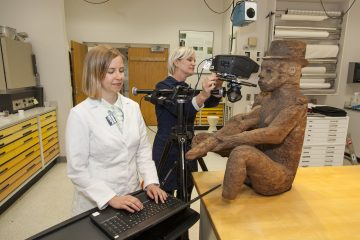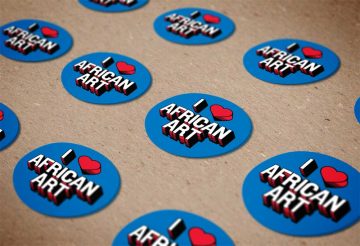Related pages: The Kingdom of Benin | The Raid on Benin, 1897
Begin and end with the object.
—Roy Sieber, 1992
—Roy Sieber, 1992
The power of artworks to instill wonder and inspire curiosity fuels scholarly research, the development of collections, and the founding of museums. The National Museum of African Art was founded in 1964 as a private museum by Warren M. Robbins in response to the Civil Rights movement. It became part of the Smithsonian Institution in 1979 and opened on the National Mall in 1987. The museum’s collection embraces the artistic expressions of Africa, from ancient to contemporary times. Its strength lies in its depth and diversity and in the exceptional artistry of objects that continue to engage the eye and mind of those who encounter them.
 Roy Sieber was a visionary scholar in the field of African art history—indeed, in 1957, he was the first scholar in the United States to earn a Ph.D. in the discipline. Between 1983 and 1994, he served as the associate director of research and collections at the National Museum of African Art and helped build the museum’s collection. Through his teaching, publications, and exhibitions, he encouraged countless students, collectors, and the general public to broaden the scope and appreciation of Africa’s arts.
Roy Sieber was a visionary scholar in the field of African art history—indeed, in 1957, he was the first scholar in the United States to earn a Ph.D. in the discipline. Between 1983 and 1994, he served as the associate director of research and collections at the National Museum of African Art and helped build the museum’s collection. Through his teaching, publications, and exhibitions, he encouraged countless students, collectors, and the general public to broaden the scope and appreciation of Africa’s arts.
The formation and ongoing development of a museum collection relies upon the solid scholarship, the eye for quality, and technical expertise that curators and conservators bring to their work.
Image caption: Conservators examine an Mbembe figure in the National Museum of African Art’s conservation lab, 2017
Photograph by Franko Khoury
Mbembe artist
Cross River State, Nigeria
Male figure, fragment of a slit gong
19th to early 20th century
Wood, seeds, pigment
77.8 x 37.9 x 73.7 cm (30 5/8 x 14 15/16 x 29 in.)
Gift of Heinrich Schweizer in memory of Merton D. Simpson, 2016-12-1
NEW ACQUISITION | A pair reunited. These two visually powerful and enigmatic wood carvings are fragments from massive slit gongs, which were sounded to call a Membe community together in case of military attacks, fire, deaths, or other important events.
Imagine the excitement when a generous patron of the arts offered to donate the magnificent seated male figure to the museum’s collection! A 2014 exhibition at the Metropolitan Museum of Art identified the male figure as the long-lost mate of the female figure, which was acquired by the National Museum of African Art in 1985.
Looking closely, do you see the stylistic similarities in the two figures? They share oval eyes of inlaid lead; ears, nose, and lip shapes; the weathering of the wood. The figures depict the important and complimentary roles of men and women in Mbembe society. Markers such as a top hat and gun denote male; an elaborate coiffure and leopard tooth necklace, the female holding a child on her lap.
Mbembe artist
Cross River State, Nigeria
Female figure, fragment of a slit gong
19th to early 20th century
Wood, seeds, pigment
68 x 48.5 x 50 cm (26 3/4 x 19 1/8 x 19 11/16 in.)
Museum purchase, 85-1-12
NEW ACQUISITION | A pair reunited. These two visually powerful and enigmatic wood carvings are fragments from massive slit gongs, which were sounded to call a Membe community together in case of military attacks, fire, deaths, or other important events.
Imagine the excitement when a generous patron of the arts offered to donate the magnificent seated male figure to the museum’s collection! A 2014 exhibition at the Metropolitan Museum of Art identified the male figure as the long-lost mate of the female figure, which was acquired by the National Museum of African Art in 1985.
Looking closely, do you see the stylistic similarities in the two figures? They share oval eyes of inlaid lead; ears, nose, and lip shapes; the weathering of the wood. The figures depict the important and complimentary roles of men and women in Mbembe society. Markers such as a top hat and gun denote male; an elaborate coiffure and leopard tooth necklace, the female holding a child on her lap.
Bamum artist
Fumban, Grassfields region, Cameroon
Male figure
Late 19th century
Wood, brass, cloth, glass beads, cowrie shells
160 x 39.4 x 36.8 cm (63 x 15 1/2 x 14 1/2 in.)
Gift of Evelyn A.J. Hall and John A. Friede, 85-8-1
CURATORIAL RESEARCH | Gestures of respect. This rare freestanding male figure was previously in the collection of the Museum für Völkerkunde in Berlin (1908–24). King Njoya (c. 1876–1933) of the Bamum kingdom donated it to commemorate German colonial official Captain Hans Glauning.
The gesture, adornment, and motifs indicate that it is portrait of a Bamum nobleman. The gesture of the left hand supporting the chin is a sign of respect. The European beads and sheet-metal appliqué (on the face and feet) of this royal figure show the impact of imported materials.
During her years leading the museum’s Eliot Elisofon Photographic Archives, scholar Christraud Geary undertook research that expanded our understanding of this figure and the iconography of art from this region. She illuminated how King Njoya strategically used art and photography to enhance the prominence of his kingdom, and himself, during the colonial period.
Lynette Yiadom-Boakye
b. 1977, London
Works in London
Womanology 12
2014
Oil on canvas
184.8 x 164.3 x 5.7 cm (72 3/4 x 64 11/16 x 2 1/4 in.)
Museum purchase, 2015-5-1
NEW ACQUISITIONS | Looking. In this canvas, a confident woman in a scarlet dress and matching hat emerges from a swirling backdrop of blue and black. She holds in her hands a pair of binoculars as she looks purposefully off into the distance—unaware or unconcerned that someone may be looking at her.
In an era in which figurative painting has been underappreciated, Lynette Yiadom-Boakye has embraced the genre through her understanding of color, surface, composition, and economy of line. The artist does not consider her large-scale paintings and etchings to be portraiture. The characters that inhabit her work are based on neither acquaintances nor models; rather, she works according to categories, such as views of backs, full-length figures, and seated figures.
After completing her paintings, Yiadom-Boakye pairs them with evocative titles that may refer to a place, day, or literary fragment. Her titles seem to heighten the tension between the reality and fiction of her characters. Womanology 12 suggests there might be earlier works in a series we have yet to encounter. The artist has dropped us into the middle of a story for which we must imagine the past and future.
thanks a lot
